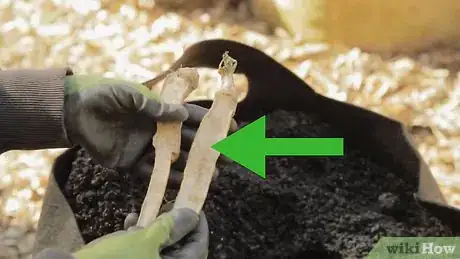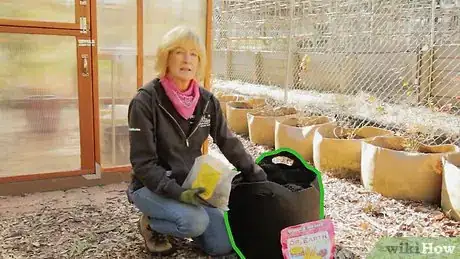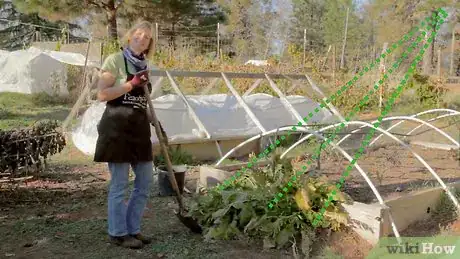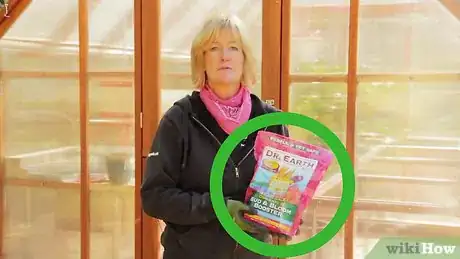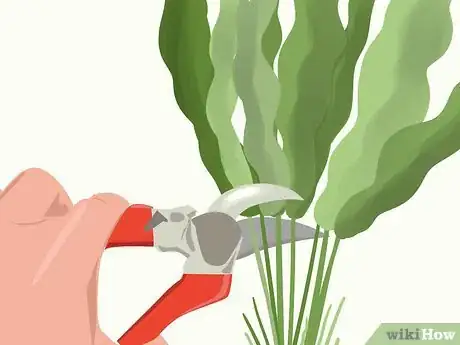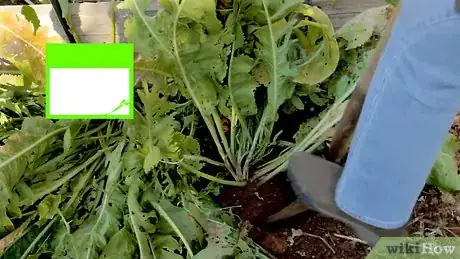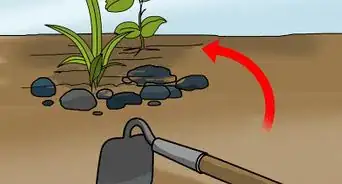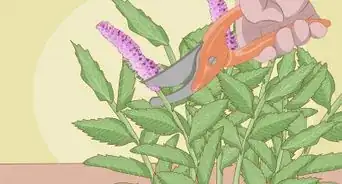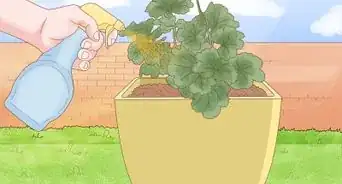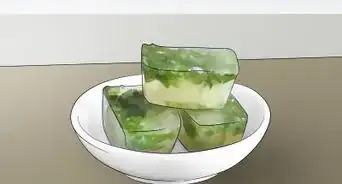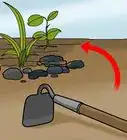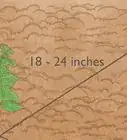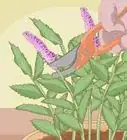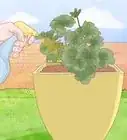This article was co-authored by Andrew Carberry, MPH. Andrew Carberry is a Food Systems Expert and the Senior Program Associate at the Wallace Centere at Winrock International in Little Rock, Arkansas. He has worked in food systems since 2008 and has experience working on farm-to-school projects, food safety programs, and working with local and state coalitions in Arkansas. He is a graduate of the College of William and Mary and holds a Masters degree in public health and nutrition from the University of Tennessee.
wikiHow marks an article as reader-approved once it receives enough positive feedback. In this case, 98% of readers who voted found the article helpful, earning it our reader-approved status.
This article has been viewed 171,273 times.
Horseradish is a pungent root vegetable that is commonly used to impart a zesty, hot flavor to foods. Horseradish is a hardy perennial, and can be grown in cold climates, full sun, or light shade. Planting horseradish in your home garden will supply you with an abundance of the vegetable right at your fingertips, which you can use to season meats, fish, soups, sauces or even add to a fresh mixed salad for a little extra kick.
Steps
Planting Horseradish
-
1Obtain horseradish crowns or roots to plant. Purchase a cutting of horseradish from a greenhouse or grocery store. Most of the time, these places will sell crowns (the uppermost part of the plant) or roots that are pre-cut and ready to plant. Most gardeners start horseradish from crowns, as the plant grows from the roots and only its weed-like flowers produce seeds.[1]
- Like carrots or potatoes, horseradish roots are ready to go straight into the ground.
-
2Find an out of the way place to plant the horseradish. Set aside an area in the corner of your garden to plant the horseradish crop, or designate a unique space such as a barrel or hanging planter to keep it from overtaking other plants. Horseradish takes roots quickly and flourishes in cool conditions, and it can quickly spread throughout your garden if you don’t check its growth.[2]
- Horseradish is a perennial, so plant it somewhere you'd like to have it growing for years to come.
- If you are working with a smaller garden, look into alternative planting methods such as terracing or using contained planting methods like a half barrel or Smart Pot.[3]
Advertisement -
3Dig a hole about a foot deep. Loosen the soil about 12 inches deep where you decide to plant the horseradish. Make the hole wide enough to accommodate the entire length of the root, as it should be planted at an angle. Space the horseradish 18-20 inches (46-51 centimeters) away from the nearest plant so that the roots have plenty of room to spread and grow.[4]
-
4Plant the horseradish diagonally. Place the horseradish crown or root into the hole at roughly a 45 degree angle, with the thinner, bottom portion of the root slanted down. This will allow the roots to radiate out beneath the soil while keeping the leaves of the crown vertical above ground. Fill the hole with a shovelful of compost to act as a fertilizer.
- Horseradish roots can be buried completely, or you can leave the top of the root visible to track its development.
Growing Horseradish
-
1Make sure the plant gets plenty of sunlight. Horseradish should ideally be grown somewhere open with ample sun exposure, but a slightly shaded area is also acceptable. Unlike more temperamental plants, horseradish doesn’t require direct sunlight to thrive, although it will help it grow faster. Avoid planting horseradish near walls or fences or beneath trees that might strangle root growth.[5]
- Horseradishes are perennial plants, so they will come back every year.
-
2Water the horseradish once or twice a week. Horseradish roots are very good at retaining moisture and therefore only require watering once or twice throughout the week. Water horseradish plants more frequently in the hot summer months when the soil tends to be drier. Be careful not to overwater horseradish, as this is one of the few conditions that can be harmful to its survival.[6]
- When watering horseradish, it’s only necessary to keep the soil around the roots slightly damp. Don’t drown them.
-
3Fertilize as needed. Fertilize during the spring with a high-phosphorus, low-nitrogen fertilizer. Fertilizing is optional, as the compost you used to plant the horseradish should provide sufficient nourishment, but can help the roots grow larger. Keep an eye on the progress of developing horseradish plants and use a fertilizer if the plants’ growth seems stunted or if soil health is poor.[7]
- Do not fertilize more than once per growing season: in the case of horseradish, once a year in the springtime.
-
4Prune suckers and weeds from the plant. As the horseradish grows, it will begin to sprout tall leaves known as “suckers” and various types of weeds. Keep these pruned down to prevent them from spreading. A healthy horseradish plant should have only 3-4 leaf stalks—any more may cause unintended spreading and irregular shaped roots should they be allowed to continue growing.[8]
- Horseradish weeds can also spread undesirably to other plants.
- Some weeds take the form of tall, spiked stalks that grow white flowers. This is a common sign that the horseradish has survived the harshest winter weather.[9]
Harvesting and Replanting Horseradish
-
1Wait until late fall to harvest horseradish. A cold-hardy vegetable, horseradish reaches its peak in size and flavor after it has been through a frost, so wait until late fall to harvest horseradish crops. It usually takes around one year for a horseradish plant to reach maturity after its initial planting, so if you first planted the root in fall it should be ready to harvest by the following fall.[10]
- The growing season for horseradish is one year from fall to fall.
- A harsh frost will often kill off the foliage that grows at the crown of the plant. This is a good way to know when the horseradish is ready to be pulled.[11]
-
2Loosen the soil around the roots and remove the plant. Use a shovel or trowel to gently loosen the soil beneath the plant’s leaf stalks. Once the root is visible, take hold of it and pull until the entire root system has been removed. Fully-grown horseradish plants will be between 6-10 inches in length, so dig deep to keep from damaging the root.[12] [13]
- Accidentally severing any part of the root may result in unwanted growth and spreading.
-
3Cut away small sections of horseradish to use or store. Snip away the green leaf stalks on the horseradish crown. These can be thrown away or used as compost. Cut the horseradish into small, thin sections that can easily be used later for cooking or other purposes. Unused horseradish can be stored in a plastic sandwich bag and will keep in the refrigerator for 3 months or longer.[14] [15]
- If you know you want to continue growing horseradish, let a few root segments remain in the soil when you harvest.
- Wash and dry horseradish roots thoroughly before using them to prepare food.
-
4Replant roots sections to keep the plant growing. If you decide to replant the harvested horseradish, cut the plant roughly 3-4 inches beneath the crown (around the root’s midpoint) and return the root portion to the soil, keeping the crown portion to use in the kitchen. The roots will reestablish themselves on their own, and you can resume regular watering and weeding.[16]
- Although the crown of the horseradish can produce a new plant, best results will be achieved by replanting the root system.
- If you don’t want the horseradish plant to return after a harvest, you’ll need to make sure that all traces of the plant’s roots have been removed from the soil. Otherwise, they will continue to take up growing.[17]
Expert Q&A
Did you know you can get expert answers for this article?
Unlock expert answers by supporting wikiHow
-
QuestionWe grate the horseradish root for Easter. Will the root keep till then if picked after the first heavy frost?
 Andrew Carberry, MPHAndrew Carberry is a Food Systems Expert and the Senior Program Associate at the Wallace Centere at Winrock International in Little Rock, Arkansas. He has worked in food systems since 2008 and has experience working on farm-to-school projects, food safety programs, and working with local and state coalitions in Arkansas. He is a graduate of the College of William and Mary and holds a Masters degree in public health and nutrition from the University of Tennessee.
Andrew Carberry, MPHAndrew Carberry is a Food Systems Expert and the Senior Program Associate at the Wallace Centere at Winrock International in Little Rock, Arkansas. He has worked in food systems since 2008 and has experience working on farm-to-school projects, food safety programs, and working with local and state coalitions in Arkansas. He is a graduate of the College of William and Mary and holds a Masters degree in public health and nutrition from the University of Tennessee.
Food Systems Expert
-
QuestionWhen is the best time to plant horseradish??
 Andrew Carberry, MPHAndrew Carberry is a Food Systems Expert and the Senior Program Associate at the Wallace Centere at Winrock International in Little Rock, Arkansas. He has worked in food systems since 2008 and has experience working on farm-to-school projects, food safety programs, and working with local and state coalitions in Arkansas. He is a graduate of the College of William and Mary and holds a Masters degree in public health and nutrition from the University of Tennessee.
Andrew Carberry, MPHAndrew Carberry is a Food Systems Expert and the Senior Program Associate at the Wallace Centere at Winrock International in Little Rock, Arkansas. He has worked in food systems since 2008 and has experience working on farm-to-school projects, food safety programs, and working with local and state coalitions in Arkansas. He is a graduate of the College of William and Mary and holds a Masters degree in public health and nutrition from the University of Tennessee.
Food Systems Expert
-
QuestionCan I freeze horseradish?
 Community AnswerYes, you can.
Community AnswerYes, you can.
Warnings
- Horseradish has a naturally hot flavor very similar to Japanese wasabi. Use it sparingly in food or cut down on the heat by balancing it with white vinegar or blending it into creamy sauces.⧼thumbs_response⧽
Things You'll Need
- Horseradish crowns or roots
- Garden space or planter
- Compost
- Water
- Shovel or trowel (for planting and harvesting)
References
- ↑ http://www.motherearthnews.com/organic-gardening/vegetables/growing-horseradish-zw0z1401zsto.aspx
- ↑ http://www.motherearthnews.com/organic-gardening/vegetables/growing-horseradish-zw0z1401zsto.aspx
- ↑ https://www.youtube.com/watch?v=1_8iYe2qDo8
- ↑ http://www.rodalesorganiclife.com/garden/grow-prepare-horseradish
- ↑ http://www.gardeningblog.net/how-to-grow/horseradish/
- ↑ http://www.rodalesorganiclife.com/garden/grow-prepare-horseradish
- ↑ https://www.youtube.com/watch?v=1_8iYe2qDo8
- ↑ http://www.rodalesorganiclife.com/garden/grow-prepare-horseradish
- ↑ http://www.motherearthnews.com/organic-gardening/vegetables/growing-horseradish-zw0z1401zsto.aspx
- ↑ http://www.gardeningblog.net/how-to-grow/horseradish/
- ↑ http://www.rodalesorganiclife.com/garden/grow-prepare-horseradish
- ↑ http://www.motherearthnews.com/organic-gardening/vegetables/growing-horseradish-zw0z1401zsto.aspx
- ↑ https://www.youtube.com/watch?v=1_8iYe2qDo8
- ↑ http://www.rodalesorganiclife.com/garden/grow-prepare-horseradish
- ↑ http://www.gardeningblog.net/how-to-grow/horseradish/
- ↑ http://www.motherearthnews.com/organic-gardening/vegetables/growing-horseradish-zw0z1401zsto.aspx
- ↑ http://www.gardeningblog.net/how-to-grow/horseradish/
- ↑ http://www.healthyandnaturalworld.com/use-horseradish-sinus-infections-uti-cold-flu-bronchitis/
- Videos provided by GrowOrganic Peaceful Valley
About This Article
To grow horseradish, plant horseradish crowns or roots at a 45-degree angle in your garden where there’s ample sun. Water the horseradish once or twice a week so the soil is just damp. As your horseradish grows, regularly prune some of the tall leaves, or “suckers,” so there are just 3 or 4 at a time. You can harvest your horseradish in the late fall after its been growing for at least a year to get it at peak size and flavor. For more information from our reviewer, who’s a Professional Gardener, on harvesting and replanting your horseradish, scroll down!
